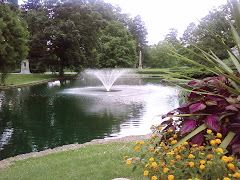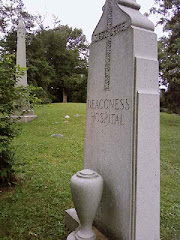Burnet was born in Newark, New Jersey, on February 22, 1770. Jacob Burnet did a lot to make the city of Cincinnati what it is today by providing a strong political standing, and presidential positions of both the  Cincinnati Astronomical Society and the Cincinnati American Colonization Society. Burnet also became president of the Medical College of Ohio. There is Burnet Woods, located in the Clifton, close to the University of Cincinnati. This was first suggested by Robert W. Burnet and William S. Groesbeck in 1871. He died on May 10, 1853 and his grave sits in Spring Grove Cemetery as an impressive mausoleum. On my first two walkabouts, I saw just how impressive the overall structure of the Second Empire French designed mausoleum is. The monument is also made of a very wonderful looking marble stone. This may say something of Burnet’s wealth as he was a very prominent man in the city of Cincinnati at one time and could afford such a luxurious mausoleum. The vast amount of flora used in the monument may be a symbolic for either a celebration of his life or a celebration of entering into the afterlife, from what I have learned about the symbolism of the poppy plant. The two infants at the top of the monument seem to symbolize more a celebration of simply life itself. I learned also, that there were a few infant deaths in the Burnet family. The infants carry a veil that drapes over the urn that sits in between them. Perhaps this could be a symbol of veil between the earth and the heavens, as stated in our Stories in Stone reading. The only religious indication that exists on the mausoleum is the small cross that hangs above the door. The symbols and icons on the mausoleum remain pretty basic and don't seem to indicate much of Jaocob Burnet's life or the beliefs of the Burnet family. I think Burnet felt that human life in general is more important than just himself and rather clutter his burial with symbols that reflect him or his family, Burnet would rather use symbols to ode human life itself. There's more in these graves, like Spring Grove itself, than meets the eye. I continue to learn, sense, and view things differently each week at the cemetery.
Cincinnati Astronomical Society and the Cincinnati American Colonization Society. Burnet also became president of the Medical College of Ohio. There is Burnet Woods, located in the Clifton, close to the University of Cincinnati. This was first suggested by Robert W. Burnet and William S. Groesbeck in 1871. He died on May 10, 1853 and his grave sits in Spring Grove Cemetery as an impressive mausoleum. On my first two walkabouts, I saw just how impressive the overall structure of the Second Empire French designed mausoleum is. The monument is also made of a very wonderful looking marble stone. This may say something of Burnet’s wealth as he was a very prominent man in the city of Cincinnati at one time and could afford such a luxurious mausoleum. The vast amount of flora used in the monument may be a symbolic for either a celebration of his life or a celebration of entering into the afterlife, from what I have learned about the symbolism of the poppy plant. The two infants at the top of the monument seem to symbolize more a celebration of simply life itself. I learned also, that there were a few infant deaths in the Burnet family. The infants carry a veil that drapes over the urn that sits in between them. Perhaps this could be a symbol of veil between the earth and the heavens, as stated in our Stories in Stone reading. The only religious indication that exists on the mausoleum is the small cross that hangs above the door. The symbols and icons on the mausoleum remain pretty basic and don't seem to indicate much of Jaocob Burnet's life or the beliefs of the Burnet family. I think Burnet felt that human life in general is more important than just himself and rather clutter his burial with symbols that reflect him or his family, Burnet would rather use symbols to ode human life itself. There's more in these graves, like Spring Grove itself, than meets the eye. I continue to learn, sense, and view things differently each week at the cemetery.
 Cincinnati Astronomical Society and the Cincinnati American Colonization Society. Burnet also became president of the Medical College of Ohio. There is Burnet Woods, located in the Clifton, close to the University of Cincinnati. This was first suggested by Robert W. Burnet and William S. Groesbeck in 1871. He died on May 10, 1853 and his grave sits in Spring Grove Cemetery as an impressive mausoleum. On my first two walkabouts, I saw just how impressive the overall structure of the Second Empire French designed mausoleum is. The monument is also made of a very wonderful looking marble stone. This may say something of Burnet’s wealth as he was a very prominent man in the city of Cincinnati at one time and could afford such a luxurious mausoleum. The vast amount of flora used in the monument may be a symbolic for either a celebration of his life or a celebration of entering into the afterlife, from what I have learned about the symbolism of the poppy plant. The two infants at the top of the monument seem to symbolize more a celebration of simply life itself. I learned also, that there were a few infant deaths in the Burnet family. The infants carry a veil that drapes over the urn that sits in between them. Perhaps this could be a symbol of veil between the earth and the heavens, as stated in our Stories in Stone reading. The only religious indication that exists on the mausoleum is the small cross that hangs above the door. The symbols and icons on the mausoleum remain pretty basic and don't seem to indicate much of Jaocob Burnet's life or the beliefs of the Burnet family. I think Burnet felt that human life in general is more important than just himself and rather clutter his burial with symbols that reflect him or his family, Burnet would rather use symbols to ode human life itself. There's more in these graves, like Spring Grove itself, than meets the eye. I continue to learn, sense, and view things differently each week at the cemetery.
Cincinnati Astronomical Society and the Cincinnati American Colonization Society. Burnet also became president of the Medical College of Ohio. There is Burnet Woods, located in the Clifton, close to the University of Cincinnati. This was first suggested by Robert W. Burnet and William S. Groesbeck in 1871. He died on May 10, 1853 and his grave sits in Spring Grove Cemetery as an impressive mausoleum. On my first two walkabouts, I saw just how impressive the overall structure of the Second Empire French designed mausoleum is. The monument is also made of a very wonderful looking marble stone. This may say something of Burnet’s wealth as he was a very prominent man in the city of Cincinnati at one time and could afford such a luxurious mausoleum. The vast amount of flora used in the monument may be a symbolic for either a celebration of his life or a celebration of entering into the afterlife, from what I have learned about the symbolism of the poppy plant. The two infants at the top of the monument seem to symbolize more a celebration of simply life itself. I learned also, that there were a few infant deaths in the Burnet family. The infants carry a veil that drapes over the urn that sits in between them. Perhaps this could be a symbol of veil between the earth and the heavens, as stated in our Stories in Stone reading. The only religious indication that exists on the mausoleum is the small cross that hangs above the door. The symbols and icons on the mausoleum remain pretty basic and don't seem to indicate much of Jaocob Burnet's life or the beliefs of the Burnet family. I think Burnet felt that human life in general is more important than just himself and rather clutter his burial with symbols that reflect him or his family, Burnet would rather use symbols to ode human life itself. There's more in these graves, like Spring Grove itself, than meets the eye. I continue to learn, sense, and view things differently each week at the cemetery. http://dynamic.cinci-parks.org/cgi-bin/parks.cgi/park_desc?park_id=59
http://dynamic.cinci-parks.org/cgi-bin/parks.cgi/park_desc?park_id=59http://www.springgrove.org/hf/history/Notables/JacobBurnet.shtm






















